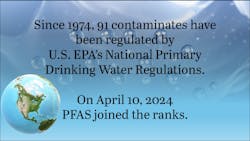"Forever chemicals" were discovered in the 1930s and have been used in manufacturing since the 1950s. They were first brought to U.S. EPA's attention in the late 1990s, and the first lawsuit to claim damages from PFAS, against DuPont, was filed in 1999. The complaining party's attorney, after the case settled, wrote a plea to U.S. EPA stating the seriousness of PFAS contamination in water.
WaterWorld editors looked through the news reporting archive, including sibling brands WasteWater Digest and Stormwater Solutions, to find key moments that lend a bird's eye view on how the water industry got to April 10, 2024, the day U.S. EPA announced the first new MCL in decades.
This is not an exhaustive list, but it does reveal the trajectory towards enforceable regulation and contains excerpts from each piece, so click the links to read more.
2017: EPA begins to investigate PFAS
Dec. 11, 2017 WaterWorld Weekly Newscast
EPA launches cross-agency effort to address PFAS
2019: EPA announces plan to address PFAS
Feb. 14, 2019 U.S. EPA outlines 5-part PFAS action plan
In an announcement that acting EPA Administrator Andrew Wheeler called historic, the U.S. EPA today outlined its plan to address contamination from per- and polyfluoroalkyl substances (PFAS) threatening drinking water resources across the country.
2019/2020: EPA spends money on PFAS research
May 3, 2019 EPA awards $3.9M for PFAS research
Two grants for research to improve understanding of human and ecological exposure to PFAS in the environment awarded to university programs.
Sept. 17, 2019 EPA awards $6M to research potential environmental impacts of PFAS waste streams
Research will expand the understanding of the environmental risks posed by per- and poly-fluoroalkyl substances (PFAS) in waste streams and identify practical approaches to manage the potential impacts as PFAS enters the environment.
Aug. 26, 2020 EPA makes nearly $5M available for new PFAS research
Funding is earmarked for managing PFAS in agricultural and rural communities.
Early 2021: EPA establishes council
April 27, 2021 EPA Administrator Regan Establishes New Council on PFAS
Radhika Fox, principal deputy assistant administrator in the Office of Water, and Deb Szaro, acting regional administrator in Region 1 will convene and lead the EPA Council on PFAS.
Late 2021: EPA announces national strategy
Oct. 19, 2021 EPA Administrator Regan Announces Comprehensive National Strategy to Confront PFAS Pollution
The Roadmap comes after a thorough analysis conducted by the EPA Council on PFAS. According to EPA, the Roadmap is centered on three strategies: Increasing investments in research; leveraging authorities to take action now to restrict PFAS chemicals from being released into the environment; and accelerating the cleanup of PFAS contamination.
Late 2021 - 2022: rulemaking begins — EPA adds PFAS to tracking/reporting list, issues advisory and declares them as hazardous
Aug. 4, 2021 EPA Releases Preliminary Data for 2020 Toxics Release Inventory Reporting
The data includes the first ever reporting on PFAS. According to the EPA news release, the preliminary data includes the first-ever reporting on per-and polyfluoroalkyl substances (PFAS) added to the TRI by the 2020 National Defense Authorization Act (NDAA).
Jan. 26, 2022 US EPA Announces Addition of 4 PFAS to the Toxics Release Inventory List
TRI data are reported to EPA annually by facilities in certain industry sectors that manufacture, process, or use TRI-listed chemicals above certain quantities. As part of the comprehensive Strategic Roadmap to tackle the health and environmental risks of PFAS, the U.S. EPA announced the automatic addition of four per- and polyfluoroalkyl substances (PFAS) to the Toxics Release Inventory (TRI) list.
June 15, 2022 EPA Announces New Drinking Water Health Advisories for PFAS Chemicals
The U.S. Environmental Protection Agency (EPA) released four drinking water health advisories for per- and polyfluoroalkyl substances (PFAS) in the latest action under President Biden’s action plan to deliver clean water and Administrator Regan’s PFAS Strategic Roadmap.
Aug. 26, 2022 EPA proposes designating PFOA, PFOS as hazardous substances
The rulemaking would recognize the dangers of two of the most widely used PFAS and would require facilities to report any releases of the substances that exceed a certain quantity.
2023: EPA enforceable MCL proposed
March 14, 2023 EPA proposes MCLs for six PFAS in drinking water
The agency announced its long-awaited National Primary Drinking Water Regulation, which proposes MCLs for PFOA, PFOS, PFNA, HFPO-DA, PFHxS, and PFBS.
The proposed rule would specifically require public water systems to: monitor for these six PFAS, notify the public of the levels of these PFAS, and reduce the levels of these PFAS in drinking water if they exceed the proposed MCLs.
April 28, 2023 EPA makes first-ever Clean Water Act enforcement for PFAS in stormwater
A West Virginia manufacturing facility has entered a consent decree to characterize and address PFAS contamination from stormwater and effluent discharges. The U.S. EPA announced that it has ordered the Chemours Company to take corrective measures to address pollution from per- and polyfluoroalkyl substances (PFAS) in stormwater and effluent discharges from the Washington Works facility near Parkersburg, West Virginia.
2024: you have arrived at your destination, but your journey has only begun
Brining the topic into the current year, 2024, Endeavor Business Media's Jeremy Wolfe (editor with Fleet Owner) wrote this piece in January outlining the atmosphere and pondering the rulemaking at that time.
The 1999 lawsuit centered around a West Virginian farmer's contaminated water. More fillings followed. According to SL Environmental, one of the law firms that has handled claims on behalf of water providers seeking recompense for water cleanup against manfacturing powerhouses, writes that legal action is a good course which historically shows results. Their step-by-step process is also a part of the WaterWorld catalog, and can be found here. However, as Mike McGill (president of WaterPIO) points out in the above referenced January 23, 2024 article, What will happen with the PFAS MCLs in 2024, some utilities do not know who their polluters are.
Furthermore, PFAS has penetrated the water cycle, so it is everywhere; without an upstream manufacturing plant, there may be no direct, sure fire route to remuneration. Some states have been working on PFAS, but with a new national goal post, compliant remediation may cost even more, and there are some providers that have not even started. Then there is the problem of material shortages, an overworked and understaffed workforce within the accelerated economy created when there is a strict, short time limit — also a worry with the recent LCRI.




